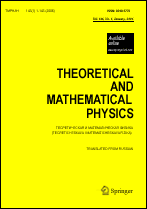|
This article is cited in 9 scientific papers (total in 9 papers)
Projective line over the finite quotient ring $GF(2)[x]/\langle x^3-x\rangle$ and quantum entanglement: The Mermin "magic" square/pentagram
M. Sanigaa, M. Planatb, M. Minarovjecha
a Astronomical Institute, Slovak Academy of Sciences
b CNRS — Institut FEMTO-ST, Département LPMO
Abstract:
In 1993, Mermin gave surprisingly simple proofs of the Bell–Kochen–Specker
(BKS) theorem in Hilbert spaces of dimensions four and eight
respectively using what has since been called the Mermin–Peres "magic"
square and the Mermin pentagram. The former is a $3\times 3$ array of nine
observables commuting pairwise in each row and column and arranged such that
their product properties contradict those of the assigned eigenvalues.
The latter is a set of ten observables arranged in five groups of four lying
along five edges of the pentagram and characterized by a similar
contradiction. We establish a one-to-one correspondence between the operators
of the Mermin–Peres square and the points of the projective line over
the product ring $GF(2)\otimes GF(2)$. Under this map, the concept mutually
commuting transforms into mutually distant, and the distinguishing
character of the third column's observables has its counterpart in
the distinguished properties of the coordinates of the corresponding points,
whose entries are either both zero divisors or both units. The ten operators
of the Mermin pentagram correspond to a specific subset of points of the line
over $GF(2)[x]/\langle x^3-x\rangle$. But the situation in this case is more
intricate because there are two different configurations that seem to serve
our purpose equally well. The first one comprises the three distinguished
points of the (sub)line over $GF(2)$, their three "Jacobson"
counterparts, and the four points whose both coordinates are zero divisors.
The other configuration features the neighborhood of the point $(1,0)$
(or, equivalently, that of $(0,1)$). We also mention some other ring
lines that might be relevant to BKS proofs in higher dimensions.
Keywords:
projective ring line, neighbor relation, distant relation, Mermin's square, Mermin's pentagram, quantum entanglement.
Received: 21.07.2006
Citation:
M. Saniga, M. Planat, M. Minarovjech, “Projective line over the finite quotient ring $GF(2)[x]/\langle x^3-x\rangle$ and quantum entanglement: The Mermin "magic" square/pentagram”, TMF, 151:2 (2007), 219–227; Theoret. and Math. Phys., 151:2 (2007), 625–631
Linking options:
https://www.mathnet.ru/eng/tmf6041https://doi.org/10.4213/tmf6041 https://www.mathnet.ru/eng/tmf/v151/i2/p219
|


| Statistics & downloads: |
| Abstract page: | 585 | | Full-text PDF : | 211 | | References: | 59 | | First page: | 1 |
|




 Contact us:
Contact us: Terms of Use
Terms of Use
 Registration to the website
Registration to the website Logotypes
Logotypes








 Citation in format
Citation in format 
